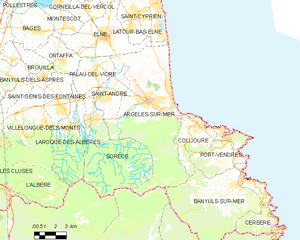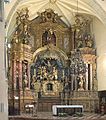Argelès-sur-Mer
|
Argelès-sur-Mer Argelers de la Marenda |
||
|---|---|---|

|
|
|
| region | Occitania | |
| Department | Pyrénées-Orientales | |
| Arrondissement | Ceret | |
| Canton | La Côte Vermeille (main town) | |
| Community association | Albères, Côte Vermeille et l'Illibéris | |
| Coordinates | 42 ° 33 ' N , 3 ° 1' E | |
| height | 0-1,099 m | |
| surface | 58.67 km 2 | |
| Residents | 10,383 (January 1, 2017) | |
| Population density | 177 inhabitants / km 2 | |
| Post Code | 66700 | |
| INSEE code | 66008 | |
 Argelès-sur-Mer |
||
Argelès-sur-Mer ( Catalan : Argelers de la Marenda or simply Argelers ) is a town with 10,383 inhabitants (as of January 1, 2017) in the Pyrénées-Orientales department in the Occitania region in southern France .
geography
The city is located on the Mediterranean Sea at the northern end of the Côte Vermeille at the foot of the Massif des Albères about 25 km northwest of the Spanish border near Cerbère . The closest major city is the city of Perpignan, about 23 km to the northwest, with about 120,000 inhabitants; The place and the cathedral of Elne (nine kilometers northwest) are also worth seeing . With the Argelès-Plage district, the city has more than seven kilometers of flat sandy beaches on the Roussillon coast and with the Le Racou district beyond the port, where the Albères come to the coast, on the rocky coves of the Côte Vermeille , which is then on the Spanish side is called Costa Brava ("Wild Coast").
Population development
| year | 1800 | 1851 | 1901 | 1954 | 1999 | 2013 |
|---|---|---|---|---|---|---|
| Residents | 1,064 | 2,325 | 3,358 | 2,907 | 9,069 | 9,914 |
At the first census in France in 1793, Argelès was a major fishing village and had 847 inhabitants. From the middle of the 19th to the middle of the 20th century the population remained roughly stable at 2,500 to 3,500 people. After the middle of the 20th century, several surrounding villages were incorporated.
economy
The most important sources of income for the city and the region include - in addition to traditional fruit and wine growing with the specialty Muscat - tourism, which also shapes the character of the place and has provided jobs and, as a result, sustained population growth in recent decades .
history
Argelès is part of the settlement history of the Mediterranean region, which can be traced back far into prehistory. Neolithic dolmens and a Bronze Age site can be found in the urban area . The place is first mentioned in a document in 879 as Villa de Argilariis .
With Roussillon, the city and the surrounding area experienced a checkered history between Spain and France as part of Catalonia until the Peace of the Pyrenees (1659).
At the end of the 19th century at the time of the Belle Époque , the first villas were built in the Argelès-Plage district and beach life was established. Art Nouveau villas by various architects on the beach promenade still bear witness to this glorious time.
Towards the end of the Spanish Civil War , the city achieved dubious notoriety because the French government there (as in other coastal towns in Roussillon, including Agde and Saint-Cyprien (Pyrénées-Orientales) ) for tens of thousands of refugees and former interbrigadists on the beach of Argelès Internment camp Argelès-sur-Mer (French: Camp de Concentration ) built. A memorial was erected after the Second World War to commemorate the suffering of those held there.
After the city merged in 2002 with 7 other municipalities in the canton to form the Communauté de communes des Albères with around 25,000 inhabitants, this merged on January 1, 2007 with the neighboring Communauté de communes de la Côte Vermeille to form a new, larger association of municipalities , the Name Communauté de communes des Albères et de la Côte Vermeille .
Attractions
Saint-Laurent-du-Mont church
The church is recognized as a monument historique .
Saint-Jerome Chapel
Others

- Notre-Dame del Prat Church - Monument historique - is in its current form a building from the 15th century; a previous building stood here as early as 920. The bell tower built in Romanesque style is interesting .
- Castle Château de Pujols (11th century) - Monument historique -; the mighty residential tower ( donjon ) stands about 1 km north of Argelès. Not far from the tower is a restored, covered well shaft.
- Château de Valmy - the manor house, built between 1888 and 1890, is about 3 km south of Argelès in the Valmy forest ( Forêt de Valmy ); it was the mansion of a rich cigarette manufacturer.
- Tour de la Massane - the lower part of the medieval watchtower (13th century) stands on a mountain peak above the Valmy forest at an altitude of 793 meters and can only be reached within a 3-hour hike.
In addition to the churches already mentioned, there are other Romanesque chapels in the vicinity of Argelès, whose purpose ( hermitage , priory church , parish church , pilgrimage chapel, etc.) can only be speculated:
- Saint-Ferréol-de-la-Pave - Monument historique - (approx. 5 km west): Pre-Romanesque building (10th century) with a horseshoe-shaped apse
- Taxo d'Avall , medieval castle ruins (11th century) with a rare two-aisled church - Monument historique - (approx. 5 km northwest)
- Notre-Dame-de-Vie : Romanesque chapel (11th century) with a Klausner apartment. Nearby: Saint-Jérôme chapel
Friends of megalithic culture will also get their money's worth in the mountains of the Albères - a total of 12 dolmens have been counted; two of them are not far from each other in the forest of Valmy (approx. 5 km south):
- Dolmen Cova de l'Alarb - Monument historique
- Collets de Collioure - Monument historique - Dolmen with missing cover plate
The Casa de les Albères museum is located in the center of the village and shows exhibits on the history of the town and the circumstances and tools of life in the 19th century and earlier.
Town twinning
The partnership with the city of Hürth near Cologne is cultivated on both sides by partnership associations and is therefore quite lively. The Collège dés Albères also conducts a student exchange with the Ernst-Mach-Gymnasium with short mutual visits.
Web links
Individual evidence
- ^ Argelès-sur-Mer - Viticulture
- ^ Church of Saint-Laurent-du-Mont in the Base Mérimée of the French Ministry of Culture (French)
- ↑ Notre-Dame del Prat Church in the Base Mérimée of the French Ministry of Culture (French)
- ↑ Château de Pujols in the Base Mérimée of the French Ministry of Culture (French)
- ↑ Saint-Ferréol-de-la-Pave in the Base Mérimée of the French Ministry of Culture (French)
- ↑ Taxo d'Avall in the Base Mérimée of the French Ministry of Culture (French)
- ↑ Cava de l'Alarb in the Base Mérimée of the French Ministry of Culture (French)
- ↑ Collets de Collioure in the Base Mérimée of the French Ministry of Culture (French)











